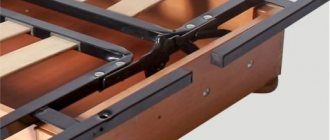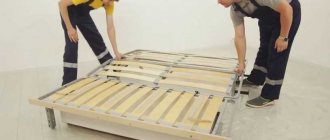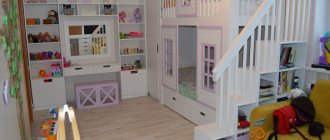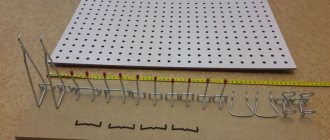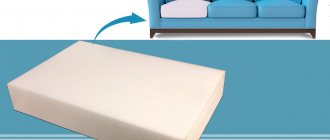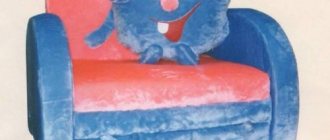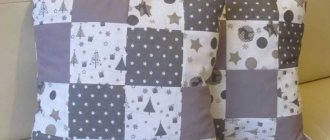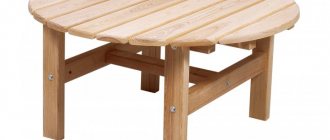Over time, any furniture loses its original properties, and the question of replacing it with something else becomes acute. Good quality furniture is quite expensive, but the old module has a strong base, and the model fits the interior.
Then DIY sofa repair becomes popular and a more economical option to get an updated piece of furniture. You can use the services of professional craftsmen or arm yourself with tools and materials and carry out all the work yourself.
Similar articles:
DIY sofa restoration DIY chest of drawers restoration How to cover a kitchen with self-adhesive film with your own hands Do-it-yourself chair repair
When to carry out repairs?
Everyone knows that a sofa is a comfortable, soft piece of furniture, created for comfort and relaxation. Of course, like any furniture, it consists of several parts.
While the product is new, everything is great, and it’s a pleasure to relax on it. However, after some time, malfunctions may appear. You may find that a spring has come out, the frame has broken, or there has been a problem with the upholstery material.
The better quality each of these parts is, the longer the sofa will last without losing its original qualities.
Replacing the spring unit may be necessary for various reasons . For example, when the action of the springs weakens, dents can be seen on the surface of the sofa. As a result, the level of comfort decreases, and using the furniture is no longer as pleasant. Sometimes you may find that a spring has snapped shortly after purchasing your sofa. This may be due to manufacturing defects or low-quality spare parts.
The solution to such a problem is clear - replacing the entire spring mechanism or, if possible, one spring.
It is necessary to resort to premature replacement of springs even if they remain intact. This happens if the rigidity of the sofa does not satisfy full comfort. This parameter cannot be adjusted in any other way. You will have to choose a more suitable spring system, which will be softer or stiffer. Of course, you can cheat and use one or more additional layers of foam rubber for softness.
Source
Let's sum it up
With some effort, you can make repairs yourself and update the upholstery of the sofa, so you don’t have to buy new upholstered furniture. The most important thing is to replace all parts of the structure that have become unusable, following the instructions, and after high-quality repairs, the sofa will last for many years.
Lately, you can often see homemade interior items made from pallets when visiting someone. These are structures used to transport goods. It turns out that it is not so difficult to make a sofa from pallets (pallets) with your own hands, and in terms of its quality it can be even better than what you can buy in a store.
Video – Restoration of a sofa with a change in design
Source
Types of spring systems
There are 4 types of springs that are used in sofas. Most of them are laid on a wood base, then covered with a layer of felt or foam rubber. Insulated systems with increased durability are also manufactured.
Main types:
- Bonnell. It is durable and reliable. It is made of high-carbon steel in the shape of glasses with two cones at the base. Placed on a plywood or MDF base. Service life is at least 10 years. The price is low, as are the orthopedic properties.
- Snake. They are fixed on a substrate made of MDF or wood with fasteners, then covered with foam rubber or felt. They are used primarily for the backrest when forming weak shock absorption. They are not resistant to regular mechanical loads, so they are not recommended for sleeping places and the base of a sofa.
- Independent. The springs are placed in a separate case, which ensures long-term operation and increased orthopedic characteristics. Mainly used in accordions and books. The more independent elements in a structure, the more reliable it is. Optimal, but expensive option.
- Multipack. A spring system with elements placed in textile covers that are connected to each other. Violation of the integrity of one spring does not reduce the performance of the entire structure. Durable if there are at least 400 elements. High price.
What is the structure of the sofa made of?
Before you begin the repair, you need to familiarize yourself with the elements that make up the design of the sofa:
The sofa consists of much larger elements than one might expect
If we are talking about a folding sofa, then the design also includes a transformation mechanism. There are several types of such mechanisms, and we will tell you more about the most popular ones in the table.
Table 1. Types of transformation mechanisms
| Type, illustration | Description |
| Such a mechanism assumes the presence of three provisions. It is often installed on modern types of sofas with slats. | |
| Thanks to the installation of such a mechanism, you can achieve a massage effect when sitting or lying down. Meralax can be metal or in the form of wooden planks. | |
| This is not a bulky, but at the same time very convenient to use mechanism. A seat is fixed to the side of the frame, which will then move apart. This is the simplest mechanism of all existing options, but at the same time it is reliable. | |
| This mechanism also suggests the presence of three folding options. Its main part is static, others move and are fixed with locks. The accordion is installed in various modern products; it cannot be found in old furniture. |
Why might they burst or come out?
A breakdown can be detected when a characteristic squeak occurs or the spring block sags when pressed. The problem arises both due to the displacement of the elements of the sofa structure, and when some of them fail.
Reasons why springs may burst:
- choosing an unsuitable spring block under different operating conditions of the sofa;
- cheap, low-quality models that become deformed and shift;
- drying out of elements, formation of cracks as a result of prolonged use;
- decrease in the elasticity of the wood substrate under the influence of moisture or sunlight;
- improper care, deformation when rearranged, expiration date;
- insufficient rigidity of the spring block, leading to uneven load on the elements.
How to replace or repair it yourself?
You can change the springs in the sofa or make minor repairs to the spring unit with your own hands, since available tools and a little time are enough for this:
- Initially, the sofa is disassembled and the cause of the breakdown is determined.
- Then the elements are repaired or replaced.
Required tools and materials
The choice of tools depends on the cause of the breakdown. If the metal has pierced the upholstery, it will need to be replaced. It is recommended to lay new insulating material during repairs - felt or foam rubber (how to choose and replace foam rubber?). It is better to replace the spring block completely.
Required tools:
- construction stapler;
- wrench;
- pliers;
- wire cutters;
- flat screwdriver;
- stationery knife;
- strong wire or twine;
- springs or new block;
- construction tape.
To collect debris between metal elements, you will need a household vacuum cleaner. Stock up on staple gun staples to reattach the upholstery and padding.
How to repair a product and restore furniture?
Before repairing, you need to disassemble the sofa:
- Dismantling begins with the side parts and armrests, since if they are attached to the legs, a wooden beam can be placed under the frame to secure this part and remove the sagging.
- Then the seat is lifted and the bolts are unscrewed with a wrench.
When the side parts are dismantled, proceed to removing the back and disassembling the transformation mechanism:
- remove the cover and upholstery from the sofa by removing the staples with a flat-head screwdriver;
- remove foam rubber and felt, look for burst or deformed springs;
- Vacuum the spring unit to remove dust and large debris;
- old but not cracked ones are reinforced with wire or twine;
- the spring block is tied around the perimeter with cobwebs for insulation;
- if the twisted elements are disconnected, bite off the sharp parts with pliers and bend them;
- bite the broken spring with wire cutters and carefully unscrew it;
- install a new element, tie it with adjacent wire;
- for safety, the wire is twisted inside the spring block;
- to completely replace the spring unit, it is necessary to remove the fastening elements around the perimeter of the structure;
- Clean the substrate with a brush, vacuum, or use a damp soft rag;
- install the new block on the substrate, secure it around the perimeter with a construction stapler;
- install staples in increments of 5–7 cm, cover problem areas in the substrate with foam rubber;
- Place a foam rubber or holofiber bedding on the installed block;
- if replacement of the filler is not required, then simply return it to its place;
- cover it with cleaned upholstery, secure the fabric with staples;
- return the side elements and backrest to their place, installing the mounting bolts with a wrench.
What is needed for a full-fledged sleeping place
Elements of furniture that can provide a good night's sleep are legs, headboard, footboard, base for the mattress and the soft part itself, which is purchased additionally. Based on this, the main effective part of the bed is the base under the mattress, the remaining parts perform supporting and decorative functions. In addition, such pieces of furniture can be additionally equipped with storage space, bedside tables that are part of the headboard and various accessories for the canopy.
When starting to remodel an old sofa, pay attention to the safety of the soft, spring or foam part; it can be used as a mattress. If small fragments have survived, it is better to use them for decoration. Wooden/plywood elements can be useful for the bed frame, headboard, footboard.
After disassembling used furniture and assessing its condition, make a list of purchasing materials necessary for the work. It may include the following items:
- Boards or plywood about 1.5-2 cm thick for lining the footboard, headboard, frame. You can use textile decoration.
- Boards or plywood about 0.6 mm thick for lamellas.
- Beam 4x4 cm for legs and support parts for the base under the mattress.
- Foam rubber with a thickness of 3 to 5 cm (as needed).
- Decorative textiles.
Craftsmen, when using the soft part of an old sofa as a mattress, as well as in transformer models, advise connecting the two halves (seat and back) with large door hinges. If you plan to assemble an open structure, you can choose decorative fittings.
A jigsaw or circular saw, a drill, a screwdriver, a jig for pocket holes (when connected with special fasteners), clamps, a furniture stapler, and sandpaper will help you get the job done quickly and accurately.
Damage and types of repair
Damage to a sofa or other upholstered furniture can vary in severity. Depending on the existing injuries, a different range of work is required. Here's what can happen to your furniture:
- Only the fabric became unusable (the cats on the armrests, for example, were torn), i.e. There are no dips in the soft part or protruding parts. Then everything is more or less simple and you can get by by replacing the upholstery fabric.
The simplest case is if you need to replace the fabric
- There are some dents in some places . This damage is caused by wear and tear on the components that make up the upholstered part of the sofa. Depending on the degree of damage and the design of the sofa itself, it may be necessary to replace padding polyester and other underlying layers. In more severe cases, repair of spring blocks, if any, or foam rubber/silicone if the sofa is spring is required. If the upholstery looks quite good, it can be washed and used again.
- Dim in the bottom of the seat. Sometimes, due to high loads, the springs pierce the bottom of the frame. This happens most often if it is made of fiberboard. In this case, you will have to disassemble everything, remove the spring dock, replace the fiberboard (preferably with plywood).
This sufferer needs more than just replacement upholstery... - Damage to the frame . One of the most unpleasant things is cracks in the frame bars. The sofa will have to be completely disassembled, the broken bars replaced, and then everything restored. This is a complete reupholstery of the sofa. Essentially, you're building a new one.
So reupholstering a sofa can involve different jobs. From simply replacing the upholstery to a complete renovation, including part of the frame. The most troublesome part is with the spring blocks. This is long and painstaking work. If the “historical accuracy” of your furniture is not important to you, it is easier to replace a failed spring block with foam rubber or (better, but more expensive) furniture silicone. If everything is done correctly, the sofa will become even more comfortable: incorrectly tightened springs cause a lot of inconvenience.
Restoration methods
Restoration of a Soviet sofa - new life for old furniture
Conventionally, the sofa can be divided into four parts. This is a wooden base made of solid wood and chipboard, steel springs and a folding mechanism, filling (foam rubber or batting) and upholstery (fabric, leather, leatherette), decorative elements (wooden overlays, buttons).
The process of reupholstering a soft sofa step by step
There are several ways to restore a sofa with your own hands, depending on the complexity:
- minor repairs to upholstery and decor;
- complete replacement of upholstery (reupholstery);
- replacement of upholstery and filling;
- replacement of upholstery, filling, repair of mechanisms;
- complete repair of all parts.
Repair of the spring mechanism, replacement of the filling and upholstery of the sofa-couch
You should not get down to business if we are talking about antiques, or if the old sofa has complex structural elements. It is also better to entrust work with capricious materials, such as leather, to professionals, or change the material to fabric.
Transformation of a leather sofa after restoration by specialists
Types of "soft part"
Let's talk in general terms about what the seat and back of the sofa can be made of. There are options:
- with classic springs connected into one block;
When restoring a sofa, you need to examine the layers.
These are the most common types of sofa seats. In more expensive models, the spring block can be supplemented with a layer of polyurethane foam or latex, which makes the seat more elastic and comfortable at the same time. When reupholstering, they then look at the condition of both parts, replace or leave them - depending on desire and capabilities.
The structure of sofa seats can be multi-layered
But that's not all the layers. In addition to springs, polyurethane foam/latex, padding polyester or thermal felt (or regular felt) are also laid. This is if the sofa is more or less modern and not too expensive. Older exhibits may contain matting or burlap, batting (or something very similar), horsehair, dried seaweed and other now almost exotic materials for sofa stuffing. When repairing a sofa, they will need to be replaced with the same ones (if you want to look) or similar in thickness and properties. So, to understand how a sofa should be reupholstered, first understand what’s inside it.
What types of springs are there?
The spring block is one of the main “components” of the sofa, therefore, when it fails, there is an urgent need to replace it. In order to understand how to do this, it is necessary to understand in more detail the types of springs.
Table 2. Types of springs used in the manufacture of upholstered furniture
| View, illustration | Description |
| This is the simplest version of the spring design, but at the same time it has good strength. This type of spring can be called budget, and its main disadvantage is that with frequent use the seat quickly sag. | |
| This is also a budget version of springs, which is also comfortable. Of the minuses, it is worth noting that over time the sofa begins to creak unpleasantly, therefore, even if one spring has become unusable, the block is often replaced. | |
| The most reliable, comfortable and durable type of spring block. If we consider the most expensive option, then in the event of a breakdown it is possible to replace any part of the unit and continue using the sofa. |
Classic sofa pie with a spring block and possible problems
To understand how to repair a sofa at home, you need to know what layers of materials are needed and in what order. For example, in a sofa seat with a spring block the sequence will be like this (from bottom to top):
- Frame made of plywood or wooden blocks . A plywood frame is more reliable, but it takes longer and is more difficult to make. Therefore, pine bars are usually used. They are connected according to the tenon-groove principle, gluing the joint with wood glue. If desired, the connections can be strengthened with dowels or corners (aluminum).
What layers should there be in a sofa seat?
This layer is needed so that the springs do not push through the foam rubber located above. These are all the layers and their features. You can add something (for example, a double layer of padding polyester), but removing it is highly undesirable.
Sofa damage: the most common problems
Of course, it is always easier to buy a new product than to repair an old one. However, in case of some problems, it is still possible to restore the structure. We will look at the most common types of damage to sofas (they also apply to other upholstered furniture):
Over time, even the most expensive upholstered furniture may require repairs
Of course, after disassembly, it is necessary to carefully assess the damage and calculate the cost of repairing the sofa. They should be no more than 50% of the cost of a new product, because in other cases it will simply not be profitable to restore it.
The design of a sofa on snake springs and options for its restoration
Snake springs in expensive models are used as an additional means to increase elasticity. In budget models, a foam block can be placed on this base. They are attached to a wooden or metal frame across the seat - each spring separately. The installation step depends on the planned load. If your sofa begins to sag, or the springs have lost their elasticity or are broken, the solution is to replace them.
To increase elasticity and extend service life, when reupholstering a sofa, the number of “snakes” can be increased. Another option is transverse reinforcement with rigid corsage ribbons (which are used for straps on bags and backpacks).
For durability and greater elasticity, use grosgrain ribbon
The tape is nailed on one side to the frame. Professional furniture makers then tighten it using a special tool, but it can be replaced with a regular block wrapped around the middle with coarse-grain sandpaper. You wrap a couple of turns of tape around this beam, pull with both hands (make sure that the frame does not bend), secure the tape with staples or nails, release and cut off the excess. The same method is also suitable for increasing the service life of a mattress with slats.
An example of sofa repair with step-by-step photos
The old sofa became completely uncomfortable, began to sag in places and creak. There is no way to buy a new one, it was decided to reupholster and change the upholstery. As usual, reupholstering a sofa begins with disassembly. The legs were removed first. The railings were fastened with two large bolts; they were unscrewed and removed without any problems. Further disassembly is also not difficult - we unscrew the bolts that appear one by one.
Dismantling the sofa
When all the components were separated, the old upholstery was removed. The staples were easy to remove - the frame was made of pine timber. The spring block itself turned out to be without defects, but there was a crack in the frame, one of the frame beams sagged, the fiberboard sagged, although there were no cracks.
Frame repair
Since the frame bears the main load, it is better to replace damaged elements. We carefully measure them, draw them schematically, and put down the dimensions in millimeters. With the drawing we go to the carpentry shop. Please pay special attention: the wood must be dry, preferably kiln dried. If you know how to work with wood yourself, you can do it yourself.
Defects close up
It was decided to connect the frame, as it was, with a tenon/groove, coated with wood glue. But to prevent it from coming loose, the connection was reinforced with metal dowels.
Reassembling the frames
First, the connections are glued and clamped in a vice. A small diameter hole is drilled under the dowel and the dowel is hammered in. The frame stands in a vice until the glue dries.
We will use 4 mm thick plywood as the base for the spring block. The sheets are standard, a little more than 1.5 meters, and the length of the sofa is almost two. It turns out two pieces. It is better to make the joint of the pieces on a jumper, it is more reliable. We cut out rectangles of the required size, coat the frame with wood glue, lay plywood, and nail it with small nails. The length of the nails is so that they do not stick out outside the frame. We additionally support the joint with a plank (50*20 mm).
Let's start re-upholstering the sofa
The updated sofa will serve in the country house, so we try to keep the budget to a minimum; we use an old blanket instead of a backing for the springs. We stretch it well and fasten it with staples using a manual construction stapler.
The base for the springs is an old fleece blanket
If possible, it is advisable to put thermal felt here. It is more reliable and not so expensive. It is cut to size, straightened and nailed around the perimeter. You can use staples or nails with large heads.
Repairing and fixing the spring block
To fasten the spring block, you can use powerful U-shaped brackets, and it is better if their legs are sharpened. But the stapler does not work with these, so we cut staples from steel wire with a diameter of 1.5 mm and hammer them in with a hammer.
Updating the sofa at home: attaching a spring block
In addition to being attached to the frame, the springs are also secured with nylon straps. Twine was taken, folded in two layers, secured with the same wire staples. We tighten the constriction so that it does not press down on the springs, but the tension should be sufficient so that the block “does not move.”
Some dense material should be placed on top of the springs, usually felt. In this case, old flooring was used. Something like felt. It is quite dense and durable. Fold in two layers, cut to size. This layer must be attached to the spring block. The coating is dense, you can’t pierce it with a needle, even a gypsy one. A large diameter awl would be suitable, but there isn't one. We pierce the coating with a nail, which we push through with the handle of a screwdriver. We thread a thick thread into the holes made. The stitch pitch is about 3.5 cm. To speed up the process, we use several nails at once.
Upholstery of a sofa from scrap materials (budget upholstery of a sofa)
Next “according to plan” there should be foam rubber, on top of which a padding polyester is placed. In this project, it was replaced with two layers of densely elastic material, which had been stored in the attic for a long time. Instead of padding polyester, another old blanket was used. To prevent the blanket from moving around, it was grabbed around the perimeter with threads (in conventional technology, synthetic winterizer is glued to polyurethane foam or latex using glue from a can).
Case and cover
Upholstering this sofa turned out to be easy: the shape is simple, without decoration. The old cover was ripped open and a pattern was made from new, not very expensive upholstery fabric. In the place that falls on the corner of the sofa cushion/seat, a thick tape was sewn from the inside to prevent the fabric from fraying. The fabric is inexpensive, so the edges had to be rolled up to prevent fraying. They are often left unprocessed.
We put the finished part in the case
The finished cover was laid out on the floor, and the restored part of the sofa was placed in it. At this stage it is important that the fabric is stretched evenly and does not wrinkle. We started nailing the cover from the middle, moving towards the edges. Staples with thick backs were used to avoid damaging the fabric.
The sofa is almost finished
The back of the sofa was restored in the same way, the armrests were covered, then all the parts were screwed to the folding mechanism. The thickness of the pillows matched, so there were no problems.
The reupholstery of the sofa is finished. Result verified
